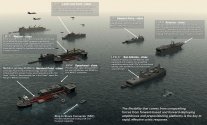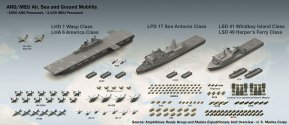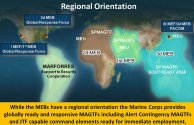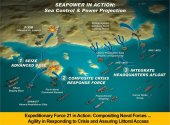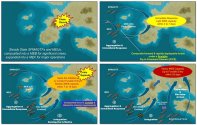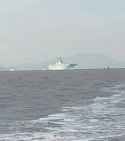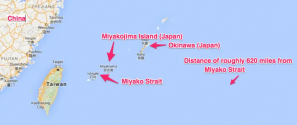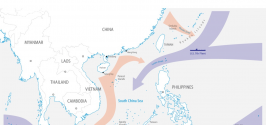- Australia has two LHDs and one LPD.
- Korea has two LPHs and zero LPDs.
- Japan has three ships which nominally are LPDs but have large landing decks.
- Italy has three small LHDs classified as LPDs and one large LHD classified as an aircraft carrier.
- France has three LHDs and zero LPDs - the LPDs replaced the LHDs.
It seems that like many others you default to mindlessly copying what the Americans are doing without trying to understand
why they are doing it.
LHD (dock) and LHA (no dock) ships were introduced into the US Navy as replacements for escort carriers which had the role of support aviation ships, especially during the Korean War. Over time as the number of carriers dwindled the number of LHDs grew to match that capability. Smaller number of super-carriers could fulfill tasks of greater number of traditional fleet carriers but they couldn't be dedicated to amphibious roles because of completely different profile of the air wing required for both missions.
Iwo Jima LHAs were built between 1959 and 1970, and Tarawa class LHDs were built between 1971 and 1980 which is exactly when the transition to first supercarrier and later nuclear supercarrier fleet occurs.
The reason why USN Expeditionary Strike Group (ESG) includes one LHD/LHA and two LPDs is because an amphibious task force doesn't need a specific group of ships - it needs
capability defined by three figures:
- cargo space
- landing craft able to operate simultaneously
- aircraft able to operate simultaneously
for the purpose of delivering the cargo to the landing zone in as short a timeframe as possible.
Once you have those constraints and the cargo consists of a battalion-size force it translates to 3-4 docks and one large landing deck for 6-8 helicopters.
A single large landing deck is better than three small landing decks because the economies of scale work better if you centralize aviation support. You can't do it with a dock unless the number of cargo becomes substantial. When that happens during larger amphibious operations centralization becomes beneficial and this is why the concept of "sea basing" was developed where regular transport ships would transfer their cargo using floating platforms so that problematic docks would not be needed.
View attachment 78068
American ESGs are designed to carry a
Marine Expeditionary Unit which is a
reinforced combined-arms battalion with supporting aviation element and resources for 15 days of fighting. The ESG is intended to operate in regions far away from US logistical infrastructure so they have to be self-sustainable for the duration of the operation because 15 days is often necessary for resupply to travel at moderate speeds (14-21 knots) from the nearest logistical facility to the staging area.
View attachment 78069
PLA is currently operating within the first island chain which is never further than 1-2 days of sailing at moderate speed from existing PLA's logistical infrastructure. All of the South China Sea is within range of immediate support from the mainland, the Parcels or Spratly archipelagos or the base in Cambodia. The second island chain extends that to about a week of travel in areas where PLAN can provide escort.
This is what USMC plans for:
View attachment 78071
PLA has currently no need to consider American solutions intended for global power projection and instead can focus on what is most important in amphibious operations which is always
securing the beachhead. The most vulnerable time for the landing force is when it is
not in the landing zone. As long as they are at sea or in the air the enemy can target them but they can't fight back. They can only take losses. Once they land the enemy has to fight them directly and they can threaten enemy infrastructure, supply lines etc. The enemy has to redirect its forces to counter direct threat and the landing fleet and support forces can now target the enemy as an additional measure, supporting the assault on land. LHDs and LHAs allow faster transit which is why they are the future of large amphibious operations.
It's precisely because of the increasing role of UAVs that I would expect that PLAN to operate primarily LHDs to expand the logistical "bandwidth" enabled by unmanned aircraft. You can't really deploy a swarm quickly and achieve surprise if you have to assemble it in the air because you have a small landing deck designed for a single helo like 071. With 075s you can both launch the swarm into the air and land it on deck at once - which is also important for considerations of fuel and range.
Take a sheet of paper and try to calculate what goes into such operation. You have some visual aids above and there is plenty of data available if you expend just a little bit of effort. Often you won't need to move beyond Wikipedia and its sources and official documents published by US Department of the Navy. For example to illustrate this comment I am using the now-superseded Expeditionary Force 21 documents released by USMC command. They are no longer relevant for USMC but they are increasingly relevant for PLAN.
Once you do that you will realize that the 071s and 075s are largely irrelevant in the case of Taiwan invasion and that their primary purpose is to secure area control in the wider region. In short why they will be definitely used for any amphibious operation against Taiwan their primary role is to ensure that the operation goes unimpeded by capturing other important islands. They will not ferry the main force to Taiwan's shores.
Here's how EF21 imagined it:
View attachment 78085
View attachment 78073
In case of Taiwan there are key outposts on the eastern side of Taiwan that if captured would become essential to isolating the island from reinforcements. Those will require 075s, not the cross-strait invasion.
Any operations in the South China Sea and beyond will require 075s, not the cross strait invasion.

